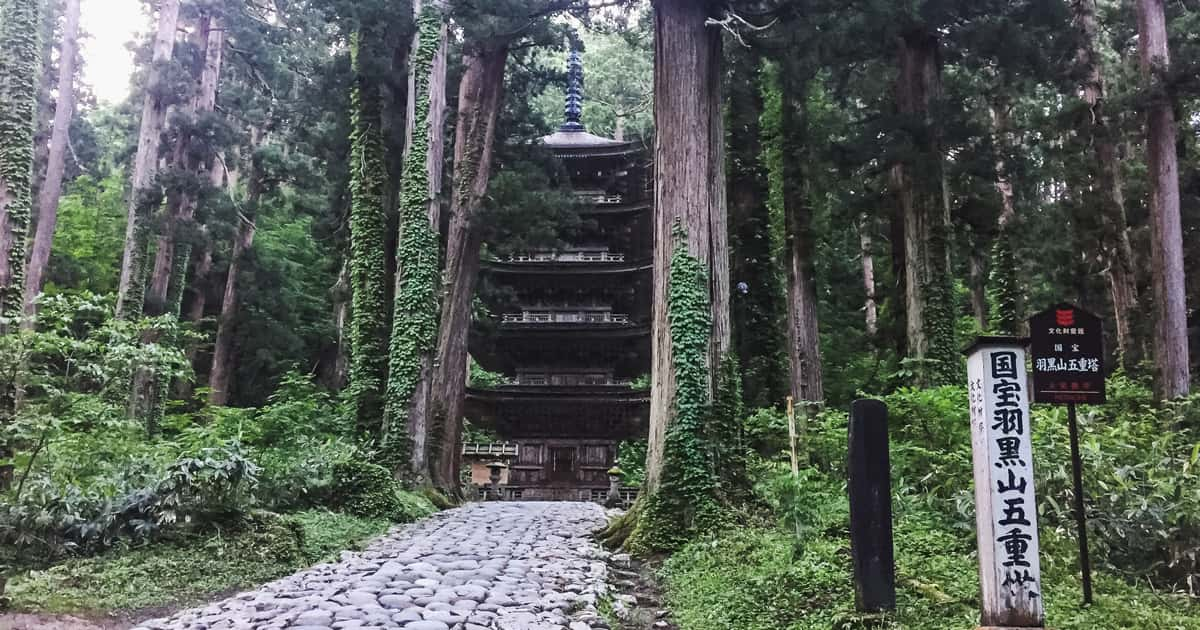
目次
- Every Season has Stunningly Beautiful Nature in the Tohoku Region!
- The three sacred mountains of Dewa, A Sacred Place for Mountain Worship
- History of the Tohoku Dewa Sanzan
- The Chance of a Lifetime to Climb Dewa Sanzan is Here!
- Tackling the Hagurosan Climb Challenge at Dawn!
- Natural Hot Springs Gushing from Yudonosan
Every Season has Stunningly Beautiful Nature in the Tohoku Region!
Japan is home to numerous towering mountains that are world-famous for their beautiful lush greenery and autumn foliage. The mountains’ changing colors have fascinated countless people and they run from Yakushima in the Nansei Islands to Asahidake, the highest peak in Hokkaido. Children from elementary school to junior high school often visit these mountains during school trips in order for them to learn the importance of experiencing nature from the mountains. Some mountains are active volcanoes that spew steam from the ground. Others have large reservoirs near their summits, and others have huge rocks exposed in various places. There are also many mountains that have been places of worship since ancient times and are known as sacred peaks. Everyone in Japan has sung the song “Usagioishi kanoyama”・・・”The Mountain Where We Chase Rabbits…” since childhood. Mountains will always be the spiritual home of the Japanese people.
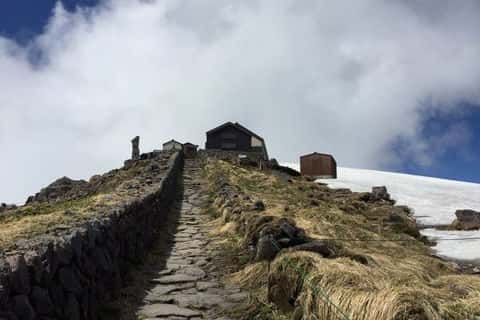
Reaching the summit of Gassan ShrineThe Tohoku region has the Ou-sanmyaku, the longest mountain range in Japan, stretching from Aomori to Tochigi prefectures. However, like the Chubu region, there are no 3,000-meter-high mountains in this region, and there are few mountains that can be considered a mecca for mountaineering. Rather, the Tohoku region is more known for its beautiful lakes such as Lake Towada and Lake Inawashiro, and there are many mountain streams in various parts of the region, such as Oirase, that offer the best nature has to offer. There are also many hot spring resorts with natural hot springs that bubble up at the foot of the mountains, like Hanamaki in Iwate Prefecture that is frequently visited by members of the royal family. Recently, Hiraizumi, which was recognized as a World Heritage Site, became a popular destination for tourists who want to enjoy its gardens and magnificent architecture and was built according to the Buddhist Pure Land philosophy against the beautiful backdrop of the mountains.
The three sacred mountains of Dewa, A Sacred Place for Mountain Worship
There are some sacred mountains in the Tohoku Region that have been revered since ancient times, and people travel there to worship them. The most worshiped are Dewa Sanzan in Yamagata prefecture. Dewa Sanzan consists of three sacred mountains, namely Haguro, Yudono, and 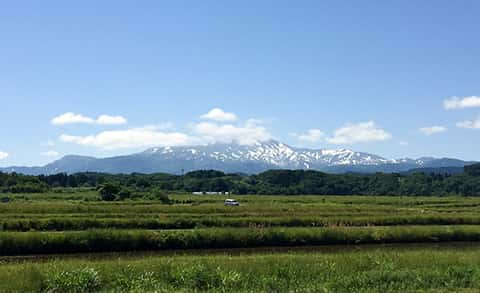
Gassan and these mountains are said to be a symbol of the past and future. Since long ago, the Ise pilgrimage has been famous for its shrine visits, but as for Eastern Japan, Dewa Sanzan has been attracting attention as the landmark to visit and worship as opposed to the west. Furthermore, the Dewa Sanzan became known as sacred grounds for Shugendo (mountain asceticism), and they have become the essential training grounds for mountain ascetics and ascetic monks studying Shugendo. Thus, since ancient times, many mountain ascetics have gathered on Dewa Sanzan donning white, to undergo ascetic practices in order to be reborn again.
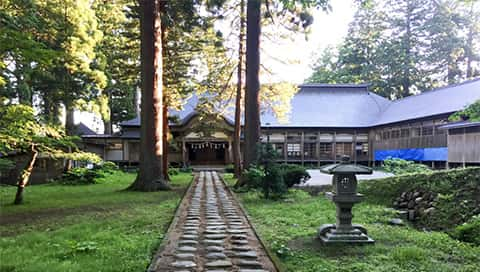
Hagurosan SaikanThe Dewa Sanzan are located in the mountain range stretching from Yamagata City into the Sea of Japan. Yamagata City is located in a basin surrounded by mountains on the east and west sides, and is at about the same latitude as Sendai City, which is only about 50 km away. From Yamagata City, 40 km to the northwest, the opposite direction of Sendai City, are Gassan and Yudonosan. Located 17 km north is Hagurosan. Since Dewa Sanzan consists of three mountains, they are fairly close to each other. However, there is a tremendous difference in their elevations. Gassan is the eighth highest mountain in the Tohoku region reaching 1,984 meters above sea level and is 2 meters higher than Ishizuchisan, the highest mountain in western Japan. Hagurosan, however, is only about one-fifth that height, or 414 meters, making it so small that it cannot be called a “high mountain”. Next, there’s also Yudonosan which is connected to Gassan and has a height of 1,500 meters.
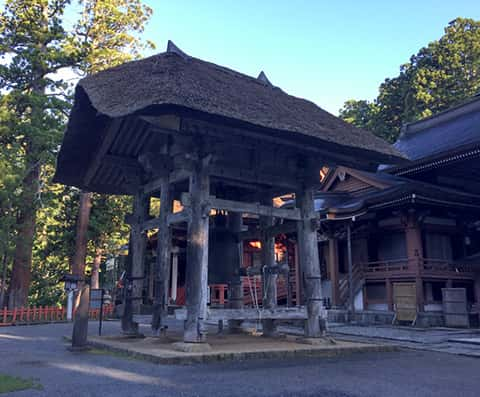
Hagurosan TaishoDespite such a large difference in elevation, the importance of the interrelationship between the spiritual mountains have been made known to the world, and this may be the reason why Dewa Sanzan has received such special attention. Furthermore, it’s remarkable that Hagurosan is the smallest out of the three mountains, has no geographical landmarks, and yet is the center of Shugendo and mountain worship. This suggests that Hagurosan is the object of mountain worship for a reason completely unrelated to the elevation of the mountains. These three mountains are always overflowing with a spiritual presence as it has also been recorded throughout history.
History of the Tohoku Dewa Sanzan
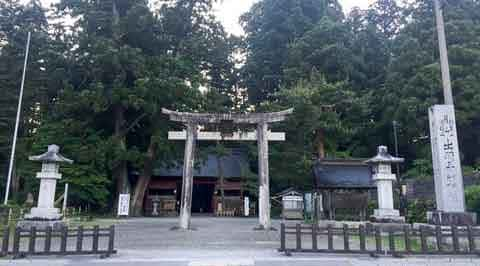
Dewa Sanzan Shrine Torii Gate at DawnDewa Sanzan is the collective name for Hagurosan, Yudonosan, and Gassan, which rise in Yamagata Prefecture (once called Dewa Province). Two deities of the Ideha Shrine that was built on Hagurosan are Idehano-kami and Ukanomita-no-mikoto. The three deities of Yudonosan Shrine are Oyamatsumi-no-mikoto, Okuninushi-no-mikoto, and Sukunahiko-no-mikoto.At Gassan Shrine, the younger brother of Amaterasu,Tsukiyomi-no-mikoto is enshrined there.
Each of the three mountains of Dewa Sanzan are reizan linked by time and space. Hagurosan is believed to be a mountain where one can obtain the benefits in this life, Yudonosan is a mountain symbolizing new life for the future, and Gassan is believed to be where one can experience the afterlife. Since the Dewa Sanzan are intrinsically intertwined as reizan with each other, so people coming to pray on them will benefit from all their abundance.
Nature worship is highly valued on the Dewa Sanzan, and they have been recognized since the early Heian period (794-1185) as mountains where Shugendo, a syncretism of Buddhism, Taoism, Confucianism, Esoteric Buddhism, Taoism, and other Shinto and Buddhist religions regularly practice their religions. Shugendo is an ancient, indigenous Japanese mountain religion that uses reizan as training grounds. This practice places people in the midst of the mountain’s vast nature for worshiping nature and becoming one with the natural world. It also aims to abide in the divine spirits through rigorous ascetic practices, and to attain enlightenment through the power of incantation and prayer. Shugendo focuses on the perceived reality of the world through the spiritual lens of esoteric Buddhism.In the Tohoku region, the three mountains of Dewa were where Shugendo was practiced.
The origin of Shugendo was on Hagurosan. Despite its low elevation, Hagurosan goes back to ancient times as the mecca of Dewa Sanzan Shugendo. The origins date back 1,400 years ago to Prince Hachinoko, son of the 32nd Emperor Sushun (587-92). At that time, the prince left Nara and traveled along the coast of the Sea of Japan where he then took a boat to head north and found Hagurosan in Yamagata. Prince Hachinoko then climbed to the top of the small mountain to worship the deity Ideha-no-kami, also known as “the god of the village of Itsuha,” and built a shrine at the top of the mountain, which is said to be the foundation of Dewa Jinja. Later, Prince Hachinoko also climbed Gassan and Yudonosan, and together the mountains are known as the Dewa Sanzan, or the “three mountains of Dewa.” The ascetic training path that Prince Hachinoko followed in finding these three mountains came to be known as Haguroha Koshugendo, which spread throughout the Tohoku region as the fundamental center of Koshugendo where Hagurosan Yamabushi and other followers trained.
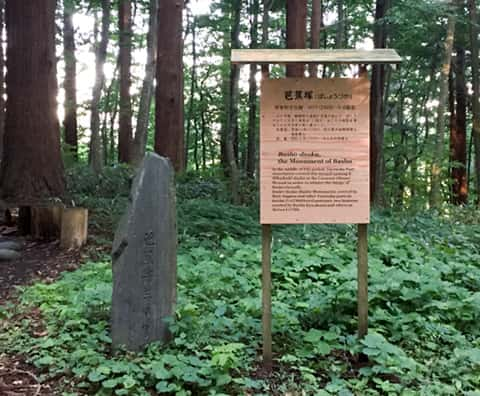
Hagurosan BashozukaThe reputation of Dewa Sanzan gradually became known throughout Japan, and it is said that Kukai, the founder of the Shingon sect of Buddhism, and Saicho of the Tendai sect of Buddhism visited Dewa Sanzan to practice asceticism there. In the Kamakura period (1185-1333), Dewa Sanzan was also called “Hasshu Kengaku no Yama” or “The Eight Schools of Buddhism Mountain,” which attracted monks from all over Japan. In the Middle Ages, Yudonosan, located in the center of the Dewa Sanzan, was recognized as the inner sanctuary. Natural hot springs gush out from the foot of Yudonosan, symbolizing the power of nature in the three mountains of Dewa to this day. Thus, climbing Dewa Sanzan became known as “Eastern okumairi” or “visiting the center” in the east as compared with the “Western Isemairi”. This pilgrimage was considered an important religious rite that one was expected to experience at least once in their lifetime.
The Chance of a Lifetime to Climb Dewa Sanzan is Here!
In the past, climbers set out to climb mountains on the Japanese archipelago on days when, bad weather often ruined mountaineering trips with dense fog preventing climbers from seeing the view from a top of the mountain. Since I had experience climbing mountains on my days off from work, I could only take one day off and could not easily change my schedule in the event of bad weather. So, I was paying special attention to weather forecasts every day before climbing. I was studying the weather map more and more, and I especially was trying to pinpoint the center of high atmospheric pressure which passes over the area where I was planning to climb. If I saw a cloudless blue sky, then I could make out the view from the top of the mountain out into the distance!
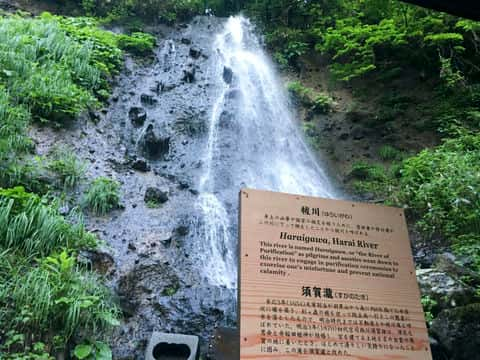
Hagurosan SugatakiMy long-awaited chance to visit Dewa Sanzan in the Tohoku region finally came in June 2017. According to the detailed weather forecast that was available on the Internet, the center of the high atmospheric pressure was predicted to pass over Dewa Sanzan on the morning of June 6. This meant that I could most likely get a spectacular view of the beautiful expansive blue sky from the top of Dewa Sanzan. According to the weather forecast, the best chance for a good view would only come in the morning, and in the afternoon the mountains would most likely be covered by clouds again. My mountain climbing time was limited from early morning until late afternoon. Therefore, I decided to set off my climb at Dewa Sanzan early in the morning on June 6. My heart was just elated at the chance to experience these mountains firsthand and get a view of the difference in elevation from Dewa Sanzan myself.
I only planned my itinerary to be one day and one night in Tohoku since I was going on my only day off. This means that I had to leave Tokyo at night after work, complete the mountain hike to the three summits of Dewa Sanzan in one day, and then take a return flight to Tokyo by the end of the day. Because I only had just enough time to climb the mountain during the day, it was no question that I had to start before sunrise in the wee hours of the morning. I checked the time at dawn and found that it was 4:00 in the morning, as it was June. It was early indeed! However, in order to climb to the summit of Dewa Sanzan and fly back to Tokyo on the same day, I told myself that I had no other choice but to get myself up at 3:45 a.m.! So, I decided to take on the challenge to leave Tokyo the night before, stay overnight in the Dewa Sanzan area, and then spend the next day having my first go at these mountains.
When it comes to Yamagata, one naturally thinks of Yamagata Airport. I initially thought that I should fly to Yamagata Airport and then climb the mountains starting east in the order of Gassan, Yudonosan, and Hagurosan. However, there were only a few flights, and the times did not match my schedule. I was having a lot of trouble finalizing my plan the night before, but then I suddenly noticed Shonai Airport along the Sea of Japan side of Yamagata Prefecture while I was looking at an airplane route map. Hagurosan is only 20 km away from Shonai Airport, and there are many inexpensive accommodations nearby! I thought, “This is it! I can start with Hagurosan, followed by Yudonosan and then go to Gassan.
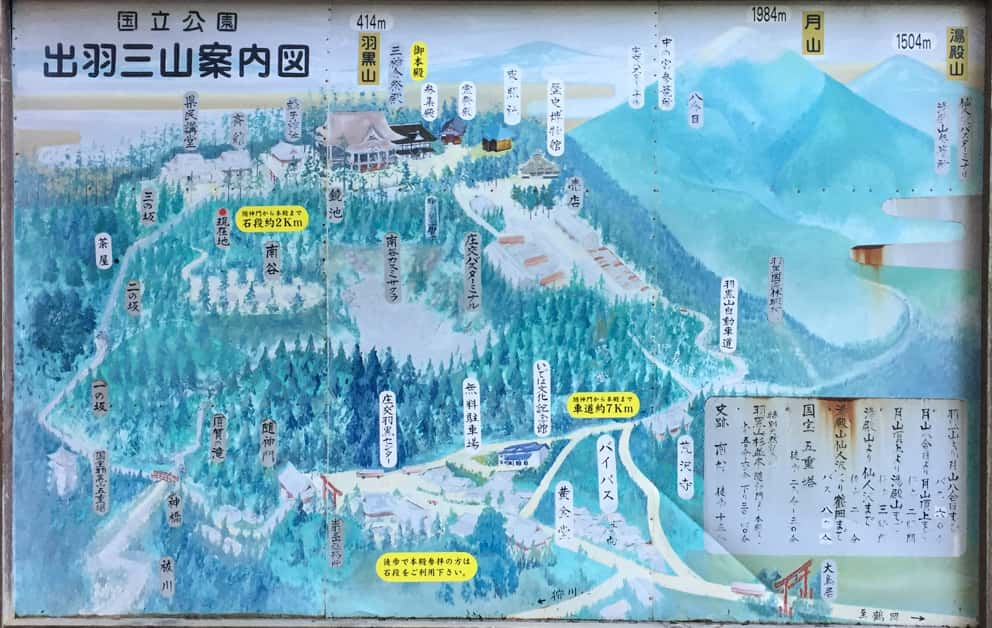
Dewa Sanzan Guide Map
Tackling the Hagurosan Climb Challenge at Dawn!
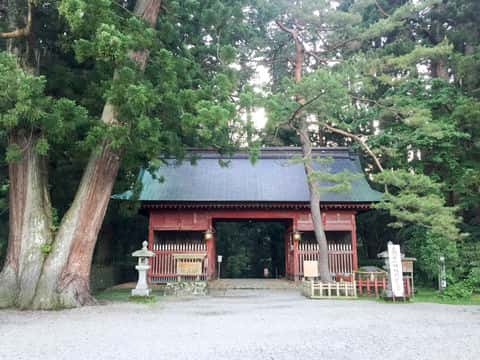
Zuishinmon, the entrance of the Hagurosan Pilgrimage RouteI arrived by car at the torii gate in front of Zuishinmon, the entrance of the Hagurosan Pilgrimage Route, at 4:20 a.m., 20 minutes later than scheduled. I already started to notice the first signs of dawn from the surrounding mountains. A stone monument next to the torii gate reads “Dewa Sanzan Jinja,” indicating that Hagurosan is the mecca of mountain worship. Passing through Zuijinmon and walking along the pilgrimage route, I noticed the many special places for soul training everywhere in the mountain wilderness.
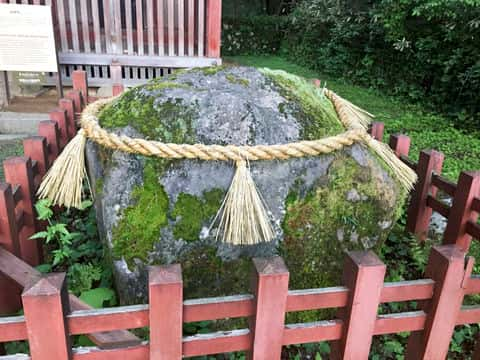
Hagurosan Tenpai-ishiThe first stone you will see is the Tenpaiseki, which is thought to be the place where people practiced ascetic training. Immediately after the Tenpaiseki, there are 2,446 stone steps, which took 13 years to build. The 1.7-kilometer pilgrimage route to the top of Hagurosan is flanked by 585 beautiful cedar trees, some of which are 300 to 500 years old. The stone steps leading up to the summit while gazing at these magnificent cedars are magnificent and a sight to behold. After crossing Shinkyo, the small waterfall that flows into the Haraigawa River can be seen, and you will see the oldest five-story pagoda in Tohoku, built by Taira-no-Masakado. The current pagoda standing was rebuilt about 600 years ago and is designated as a national treasure.
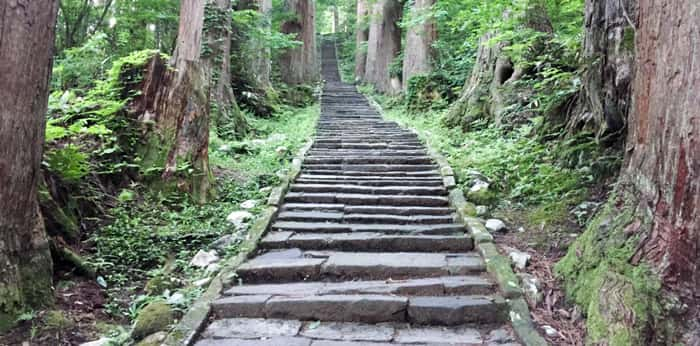
The Beautiful Stone Steps of Hagurosan in Harmony with Nature
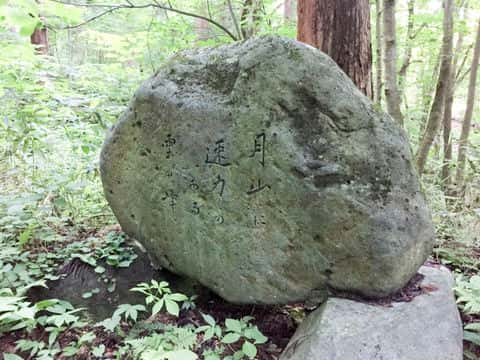
Basho’s Haiku Monument on HagurosanContinue up the first and second slopes, passing the Ninosaka Ochaya, and you will see signs of the Gohonbo ruins. Beyond that, about 500 meters to the right, the well-known Hagurosan Minamidani stands. Perhaps not many people visit this area because there are many weeds along the way and the footing is not good, but the stunning green scenery brings peace of mind to everyone. Basho Matsuo, the great haiku poet, stayed here for six days with his student Sora during his journey along the Narrow Road to the Deep North, and wrote the line for his poems, “Thankful for Minamidani for sheltering me from the snow.”
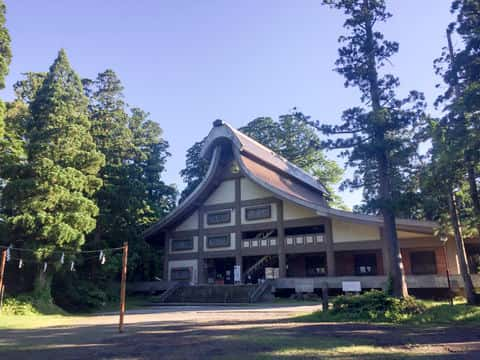
Dewa Sanzan History MuseumPassing the San-no-zaka slope of the Dewa Sanzan History Museum and continuing up the pilgrimage route with the gateway to the Saikan on the left, I reached the summit of the mountain. The time was 5:40 am which meant that I had traveled along the pilgrimage route in a little over an hour. The Sanjin Gosaiden, the largest shrine building in Japan dedicated to the three deities together, was erected at the top. In front of the shrine is a large mirror pond called Kagami-ike, which is said to have been named after a bronze mirror that was dedicated to the gods in ancient times. Beyond the Sanjin Gosaiden is the Dewa Sanzan History Museum, where visitors can learn more about the three mountains of Dewa.
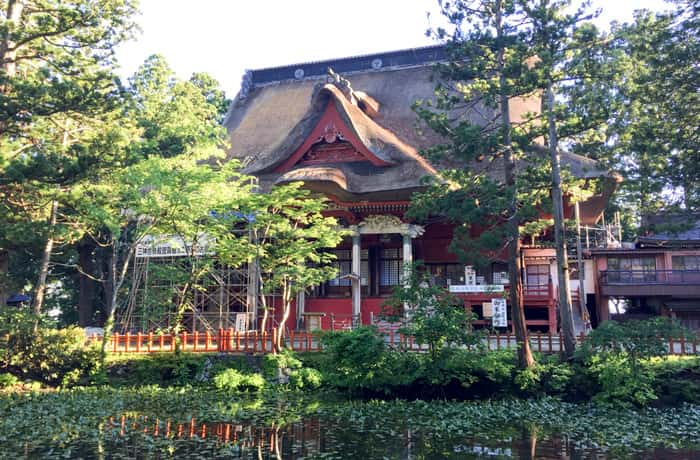
Hagurosan in the early morning with a bright blue sky.
After about 30 minutes of strolling around the summit taking pictures, I realized that it was already 6:15. I still had to get to Yudonosan and Gassan! I quickly ran down the pilgrimage route, stopping at Minamidani, the area where Basho’s Haiku monument was erected, and then came back to the torii (gate) of Dewa Sanzan Shrine. The time was 7:15. Time was just ticking away.
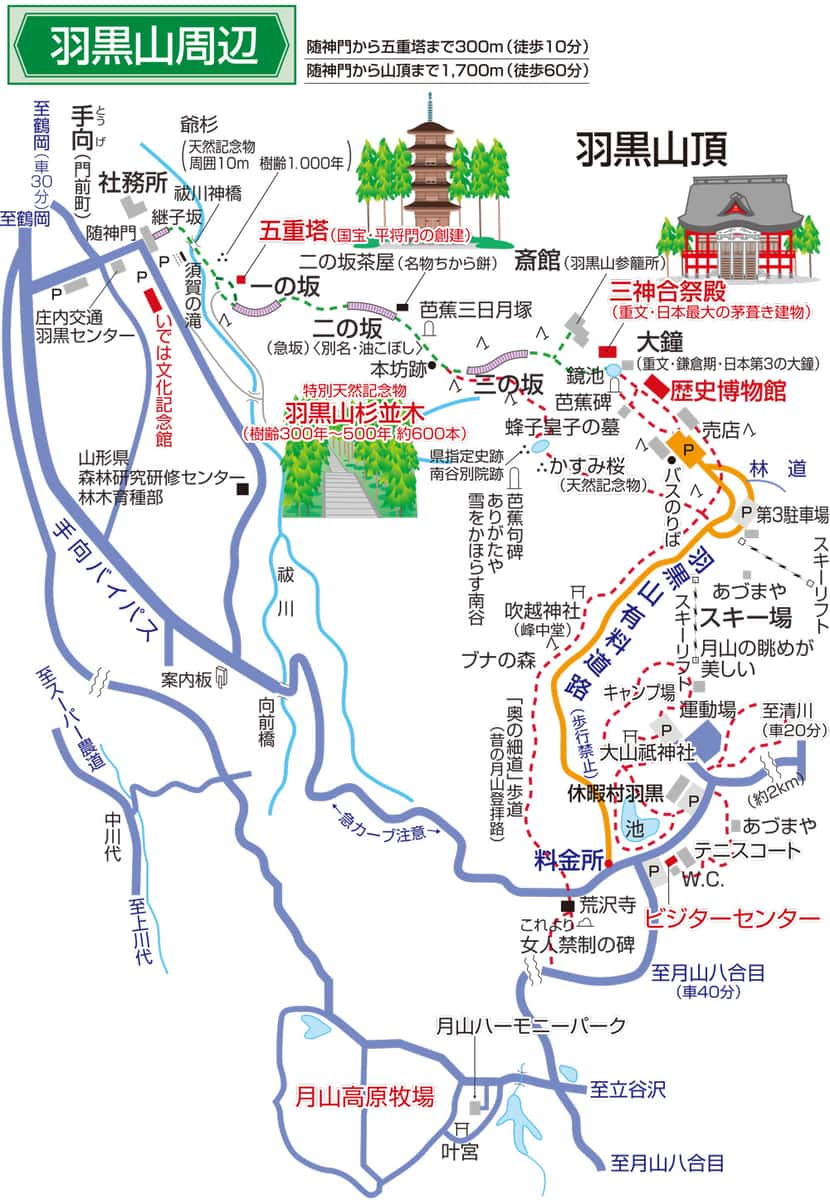
Hagurosan Area MAP
(Courtesy of Hagurosan Tourist Association)
Natural Hot Springs Gushing from Yudonosan
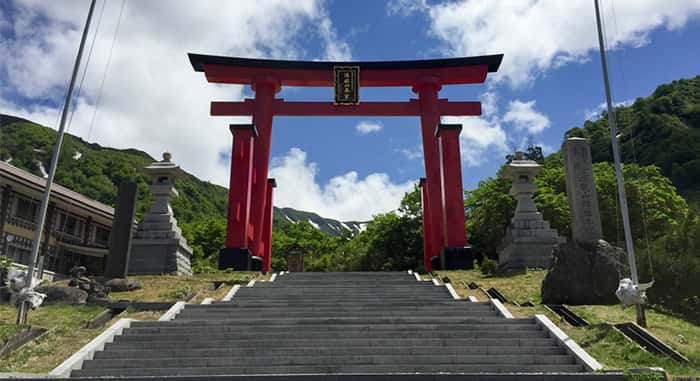
Yudono Jinja Hongu Torii (main shrine gate)
From Hagurosan to Yudonosan, the distance is less than 14 km in a straight line. However, since it is surrounded by mountains, I was forced to take a detour using the prefectural road, and the actual driving distance was more than 30 km. In addition, it was difficult to find a place to exit National Highway 112 onto the prefectural road leading to Yudonosan, even with a navigation system. I got lost on the way, so I ended up arriving at Yudonosan at exactly 10:00 a.m.
There is a large parking lot and a store there that would make you think you were in a tourist attraction, but even at 10:00 in the morning, there weren’t a lot of people. Although there is a large torii gate at the end of the parking lot, there is no road or main shrine, indicating that Yudonosan itself is the sacred site. After passing through the torii gate and walking along the paved road, I found Sanzan Jizoson and Yamamba (mountain witch) of Yudonosan enshrined along the road. After walking further, I saw stone steps, the entrance to which said “Entrance to the Main Shrine of Yudonosan Jinja, the Inner Shrine of Dewa Sanzan. This was the official start of the road. As soon as I ascended the stone steps of the road, I saw a stone monument engraved with the words “Yudonosan Shinkou Monument.” The stone monuments followed, but both were a bit crude in their construction and arrangement, and I wondered if there was something wrong with them. Immediately after that is a small waterfall that serves as the sacred body of Mitaki Jinja, which is adjacent to Yudonosan Jinja. Passing through there, you will reach the Gohonmiya Goshinyu of the Yudonosan Jinja.
The history book of the Goshintou clearly states that the belief about Yudonosan is that the time of rebirth is connected to the teaching of the three paths of the past, the present, and the future. I did not have permission to photograph the actual sacred boulder, but it is a round boulder about 10 meters in diameter, with hot spring water gushing out from various places, and the mineral spring water contains a lot of iron hydroxide that has turned the rock reddish brown in color. Visitors can walk barefoot around and experience the power of the natural hot spring water and, by extension, the divine power of Yudonosan. On the way home, visitors can take a moment to bathe their feet in the warm waters from the natural hot spring.
Now, I look at my watch and see that it is 11 a.m. There is no time to think about the fact that I still have to climb Gassan after leaving Yudonosan Jinja behind. I set off for Gassan, the highest peak in the three peaks of Dewa. (Continue to “Japanese Reizan, Climbing Record for Gassan”)

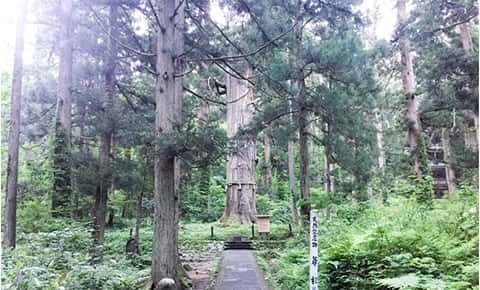
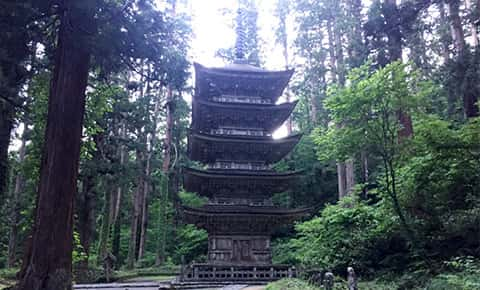
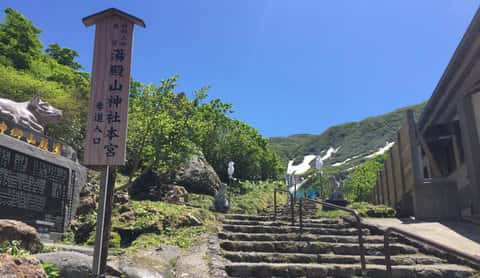
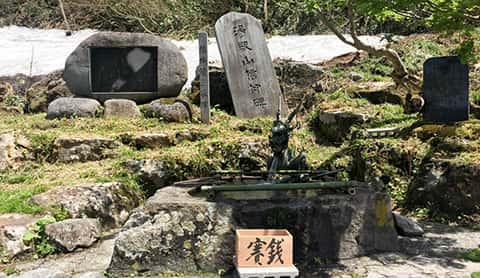
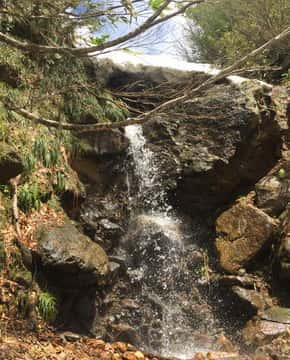 Yudonosan Jinja adjacent to Mitaki Jinja
Yudonosan Jinja adjacent to Mitaki Jinja